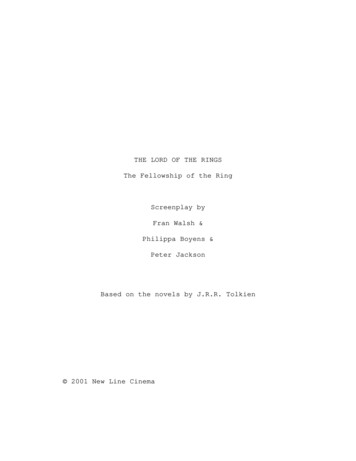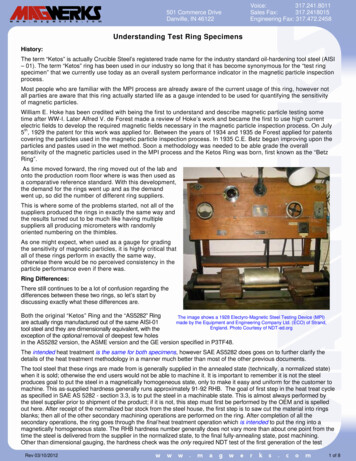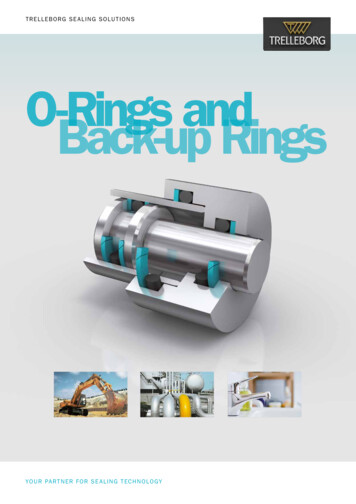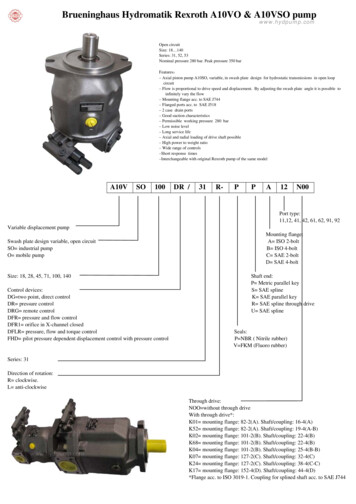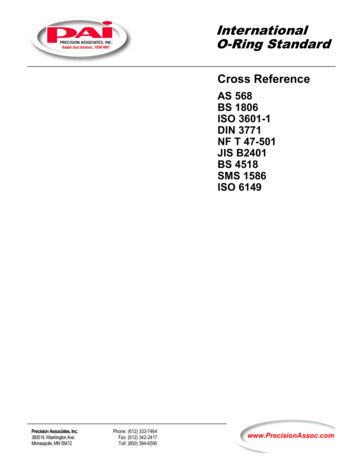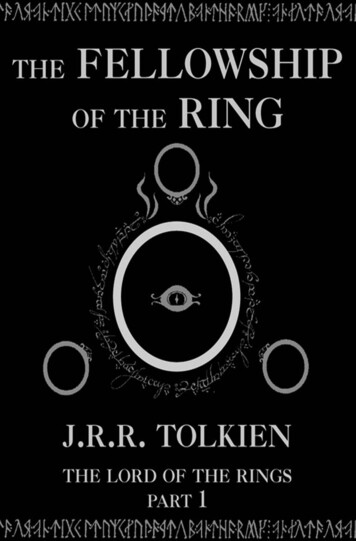
Transcription
iiiTHE FELLOWSHIPOF THE RINGbeing the first part ofTHE LORD OF THE RINGSbyJ.R.R. TOLKIEN
Three Rings for the Elven-kings under the sky,Seven for the Dwarf-lords in their halls of stone,Nine for Mortal Men doomed to die,One for the Dark Lord on his dark throneIn the Land of Mordor where the Shadows lie.One Ring to rule them all, One Ring to find them,One Ring to bring them all and in the darkness bind themIn the Land of Mordor where the Shadows lie.
.
CONTENTSNote on the TextNote on the 50th Anniversary EditionForeword to the Second EditionPrologue Concerning Hobbits, and othermattersixxviiixxiii1book oneI A Long-expected PartyII The Shadow of the PastIII Three is CompanyIV A Short Cut to MushroomsV A Conspiracy UnmaskedVI The Old ForestVII In the House of Tom BombadilVIII Fog on the Barrow-downsIX At the Sign of The Prancing PonyX StriderXI A Knife in the DarkXII Flight to the Ford275585112128143161176195213230257book twoI Many MeetingsII The Council of ElrondIII The Ring Goes South285311354
viiicontentsIVVVIVIIVIIIIXXA Journey in the DarkThe Bridge of Khazad-dûmLothlórienThe Mirror of GaladrielFarewell to LórienThe Great RiverThe Breaking of the Fellowship384418433459478495515Maps533Works By J.R.R. TolkienCopyrightAbout The Publisher540541542
.
NOTE ON THE TEXTJ.R.R. Tolkien’s The Lord of the Rings is often erroneouslycalled a trilogy, when it is in fact a single novel, consistingof six books plus appendices, sometimes published in threevolumes.The first volume, The Fellowship of the Ring, was publishedin Great Britain by the London firm George Allen & Unwinon 29 July 1954; an American edition followed on 21 Octoberof the same year, published by Houghton Mifflin Companyof Boston. In the production of this first volume, Tolkienexperienced what became for him a continual problem:printer’s errors and compositor’s mistakes, including wellintentioned ‘corrections’ of his sometimes idiosyncraticusage. These ‘corrections’ include the altering of dwarves todwarfs, elvish to elfish, further to farther, nasturtians to nasturtiums, try and say to try to say and (‘worst of all’ to Tolkien)elven to elfin. In a work such as The Lord of the Rings,containing invented languages and delicately constructednomenclatures, errors and inconsistencies impede both theunderstanding and the appreciation of serious readers – andTolkien had many such readers from very early on. Evenbefore the publication of the third volume, which containedmuch hitherto unrevealed information on the invented languages and writing systems, Tolkien received many lettersfrom readers written in these systems, in addition to numerous enquiries on the finer points of their usage.The second volume, The Two Towers, was published inEngland on 11 November 1954 and in the United States on21 April 1955. Meanwhile Tolkien worked to keep a promisehe had made in the foreword to volume one: that ‘an indexof names and strange words’ would appear in the third volume. As originally planned, this index would contain muchetymological information on the languages, particularly onthe elven tongues, with a large vocabulary. It proved the chief
xiinote on the textcause of the delay in publishing volume three, which in theend contained no index at all, only an apology from thepublisher for its absence. For Tolkien had abandoned workon it after indexing volumes one and two, believing its sizeand therefore its cost to be ruinous.Volume three, The Return of the King, finally appeared inEngland on 20 October 1955 and in the United States on5 January 1956. With the appearance of the third volume,The Lord of the Rings was published in its entirety, and itsfirst edition text remained virtually unchanged for a decade.Tolkien had made a few small corrections, but further errorsentered The Fellowship of the Ring in its December 1954second impression when the printer, having distributed thetype after the first printing, reset the book without informingthe author or publisher. These include misrepresentations ofthe original printed text – that is, words and phrases thatread acceptably in context, but which depart from Tolkien’swording as originally written and published.In 1965, stemming from what then appeared to be copyright problems in the United States, an American paperbackfirm published an unauthorized and non-royalty-paying edition of The Lord of the Rings. For this new edition by AceBooks the text of the narrative was reset, thus introducingnew typographical errors; the appendices, however, werereproduced photographically from the hardcover edition, andremain consistent with it.Tolkien set to work on his first revision of the text so thata newly revised and authorized edition could successfullycompete on the American market. This first revision of thetext was published in America in paperback by BallantineBooks, under licence from Houghton Mifflin, in October1965. In addition to revisions within the text itself, Tolkienreplaced his original foreword with a new one. He was pleasedto remove the original foreword; in his check copy, hewrote of it: ‘confusing (as it does) real personal matters withthe ‘‘machinery’’ of the Tale, is a serious mistake’. Tolkienalso added an extension to the prologue and an index – not
note on the textxiiithe detailed index of names promised in the first edition,but, rather, a bald index with only names and page references. Additionally, at this time the appendices were greatlyrevised.Tolkien received his copies of the Ballantine edition in lateJanuary 1966, and in early February he recorded in his diarythat he had ‘worked for some hours on the Appendices inBallantine version & found more errors than I at firstexpected’. Soon after this he sent a small number of furtherrevisions to Ballantine for the appendices, including the nowwell-known addition of ‘Estella Bolger’ as wife of Meriadocin the family trees in Appendix C. Most of these revisions,which entered variously in the third and fourth impressions( June and August 1966) of volume three, and which werenot always inserted correctly (thereby causing further confusion in the text), somehow never made it into the mainsequence of revision in the three-volume British hardcoveredition, and for long remained anomalies. Tolkien oncewrote, concerning the revising of The Lord of the Rings, thatperhaps he had failed to keep his notes in order; this errantbranch of revision seems likely to be an example of thatdisorder – either in his notes or in the ability of his publishersto follow them with utmost accuracy.The revised text first appeared in Great Britain in a threevolume hardcover ‘Second Edition’ from Allen & Unwin on27 October 1966. But again there were problems. Althoughthe revisions Tolkien sent to America of the text itself wereavailable to be utilized in the new British edition, his extensiverevisions to the appendices were lost after being entered intothe Ballantine edition. Allen & Unwin were forced to reset theappendices using the copy as published in the first Ballantineedition. This did not include Tolkien’s second, small set ofrevisions sent to Ballantine; but, more significantly, it didinclude a great number of errors and omissions, many ofwhich were not discovered until long afterwards. Thus, inthe appendices, a close scrutiny of the first edition text andof the much later corrected impressions of the second edition
xivnote on the textis necessary to discern whether any particular change in thisedition is authorial or erroneous.In America, the revised text appeared in hardcover in thethree-volume edition published by Houghton Mifflin on27 February 1967. This text was evidently photo-offset fromthe 1966 Allen & Unwin three-volume hardcover, and is thusconsistent with it. Aside from the first printing of this secondHoughton Mifflin edition, which has a 1967 date on the titlepage, none of the many reprintings is dated. After the initialprintings of this edition, which bore a 1966 copyright notice,the date of copyright was changed in 1965 to match thestatement in the Ballantine edition. This change has causeda great deal of confusion for librarians and other researcherswho have tried to sort out the sequence of publication ofthese editions.Meanwhile, Tolkien spent much of the summer of 1966further revising the text. In June he learned that any morerevisions were too late for inclusion in the 1966 Allen &Unwin second edition, and he recorded in his diary: ‘But Iam attempting to complete my work [on the revisions] – Icannot leave it while it is all in my mind. So much time hasbeen wasted in all my work by this constant breaking ofthreads.’ This was the last major set of revisions Tolkienhimself made to the text during his lifetime. They were addedto the second impression (1967) of the three-volume hardcover Allen & Unwin second edition. The revisions themselves mostly include corrections of nomenclature andattempts at consistency of usage throughout the three volumes. Some small alterations were made by Tolkien in the1969 one-volume India paper edition.J.R.R. Tolkien died in 1973. His third son and literaryexecutor, Christopher Tolkien, sent a large number of furthercorrections of misprints, mainly in the appendices and index,to Allen & Unwin for use in their editions in 1974. Most ofthese corrections were typographical, and in line with hisfather’s expressed intent in his own check copies.Since 1974, Christopher Tolkien has sent additional cor-
note on the textxvrections, as errors have been discovered, to the British publishers of The Lord of the Rings (Allen & Unwin, later UnwinHyman, and now HarperCollins), who have tried to be conscientious in the impossible task of maintaining a textualintegrity in whichever editions of The Lord of the Rings theyhave published. However, every time the text has been resetfor publication in a new format (e.g. the various paperbackeditions published in England in the 1970s and 1980s), hugenumbers of new misprints have crept in, though at timessome of these errors have been observed and corrected inlater printings. Still, throughout these years the three-volumeBritish hardcover edition has retained the highest textualintegrity.In the United States, the text of the Ballantine paperbackhas remained unchanged for more than three decades afterTolkien added his few revisions in 1966. The text in all ofthe Houghton Mifflin editions remained unchanged from1967 until 1987, when Houghton Mifflin photo-offset thethen current three-volume British hardcover edition in orderto update the text used in their editions. In those newreprintings a number of further corrections (overseen byChristopher Tolkien) were added, and the errant Ballantinebranch of revision (including the ‘Estella Bolger’ addition)was integrated into the main branch of textual descent. Thismethod of correction involved a cut-and-paste process withprinted versions of the text. Beginning with the 1987 Houghton Mifflin edition, an earlier version of this ‘Note on theText’ (dated October 1986) was added to The Lord of theRings. This ‘Note’ has been reworked three times since then– the version dated April 1993 first appeared in 1994, andthe version dated April 2002 came out later that year. Thepresent ‘Note’ replaces and supersedes all previous versions.For the 1994 British edition published by HarperCollins,the text of The Lord of the Rings was entered into wordprocessing files. This next stage of textual evolution cameabout to allow for a greater uniformity of the text in all futureeditions, but with it, inevitably, came new wrinkles. Some
xvinote on the textnew misreadings entered into the text, while at the same timeothers were fixed. In the worst instance, one line of the ringinscription in the chapter ‘The Shadow of the Past’ of TheFellowship of the Ring was simply dropped. Unforeseeableglitches arose in other editions when the base computerizedtext was transferred into page-making or typesetting programs – e.g., in one edition of The Fellowship of the Ring, theclosing two sentences of ‘The Council of Elrond’ simply andinexplicably disappeared. Such glitches have been very muchthe exception, not the rule, and the text has otherwise maintained a consistency and integrity throughout its computerized evolution.The 1994 edition also contained a number of new corrections (again supervised by Christopher Tolkien), as well as areconfigured index of names and page references. The 1994text was first used in American editions published by Houghton Mifflin in 1999. A small number of further correctionswere added into the 2002 three-volume edition illustrated byAlan Lee, published by HarperCollins in Great Britain andHoughton Mifflin in the United States.The textual history of The Lord of the Rings, merely in itspublished form, is a vast and complex web. In this briefnote I have given only a glimpse of the overall sequence andstructure. Further details on the revisions and correctionsmade over the years to the published text of The Lord of theRings, and a fuller account of its publishing history, may befound in J.R.R. Tolkien: A Descriptive Bibliography, by WayneG. Hammond, with the assistance of Douglas A. Anderson(1993).For those interested in observing the gradual evolving ofThe Lord of the Rings from its earliest drafts to its publishedform, I highly recommend Christopher Tolkien’s account,which appears within five volumes of his twelve-volume seriesThe History of Middle-earth. Volumes six through nine contain the major part of his study pertaining to The Lord of theRings: The Return of the Shadow (1988); The Treason of
note on the textxviiIsengard (1989); The War of the Ring (1990); and SauronDefeated (1992). Also, the final book of the series, The Peoplesof Middle-earth (1996), covers the evolution of the prologueand appendices to The Lord of the Rings. These volumescontain an engrossing over-the-shoulder account of thegrowth and writing of Tolkien’s masterpiece.The process of studying Tolkien’s manuscripts of The Lordof the Rings involved the deciphering of versions whereTolkien wrote first in pencil and then in ink atop the pencilleddraft. Christopher Tolkien has decribed his father’s methodof composition in The Return of the Shadow: ‘In the handwriting that he used for rapid drafts and sketches, not intendedto endure long before he turned to them again and gave thema more workable form, letters are so loosely formed that aword which cannot be deduced or guessed at from the context or from later versions can prove perfectly opaque afterlong examination; and if, as he often did, he used a soft pencilmuch has now become blurred and faint.’ The true difficultyof reading such double-drafts can be observed in the frontispiece to The War of the Ring, which reproduces in colourTolkien’s illustration of ‘Shelob’s Lair’ from a page ofTolkien’s manuscript. Looking very closely at the hasty inkdraft alongside the illustration, one can see underneath it theearlier, hastier, pencilled draft. Also in The War of the Ring,Christopher Tolkien reproduces a page from the first manuscript of the chapter ‘The Taming of Sméagol’, and theprinted text corresponding to this text is on the facing page(see pp. 90–91). One is astonished at anyone’s ability todecipher such texts.That difficulty aside, just what do these books signify toordinary readers and to Tolkien scholars? And what is ‘thehistory of the writing’ of a book? Simply, these volumes showin great detail the development of the story of The Lord ofthe Rings from its very earliest drafts and hasty projectionsthrough its completion. We see in the earliest materials whatis very much a children’s book, a sequel to The Hobbit, andas the story grows through various ‘phases’, there is an
xviiinote on the textincrease in seriousness and depth. We see alternate branchesof development, the gradual blending and merging of certaincharacters, and the slow emergence of the nature of the ringsand of the motivations of other characters. Some of thesevarious ideas are abandoned altogether, while others arereworked into some variant form that may or may not surviveinto the final version.One could make a whole catalogue of interesting tidbitsfrom Christopher Tolkien’s study – such as the fact thatStrider was called Trotter until a very late stage in the writingof the book; that Trotter was at one time a hobbit, so namedbecause he wore wooden shoes; that Tolkien at one pointconsidered a romance between Aragorn and Éowyn; thatTolkien wrote an epilogue to the book, tying up loose ends,but it was dropped before publication (and now appears inSauron Defeated ); and so on. But these developments are bestappreciated when read within the context of ChristopherTolkien’s commentary rather than discussed separately.The most significant achievement of these volumes is thatthey show us how Tolkien wrote and thought. Nowhere elsedo we see the authorial process itself at work in such detail.Tolkien’s hastiest comments about where the story mightproceed, or why it can or can’t go such and such a way –these queries to himself were written out: Tolkien is literallythinking on paper. This gives an added dimension of understanding to Tolkien’s comment to Stanley Unwin in a 1963letter that, when suffering from trouble with his shoulder andright arm, ‘I found not being able to use a pen or pencil asdefeating as the loss of her beak would be to a hen.’ And we,as readers of these volumes, can share with Tolkien himselfthe wonder and bewilderment of new characters appearingas if from nowhere, or of some other sudden change or development, at the very moment of their emergence into thestory.I know of no other instance in literature where we havesuch a ‘history of the writing’ of a book, told mostly by theauthor himself, with all the hesitations and false paths laid
note on the textxixout before us, sorted out, commented upon, and served upto a reader like a feast. We are shown innumerable instancesin the minutest detail of the thought-process itself at work.We see the author fully absorbed in creation for its own sake.And this is all the more exceptional because this is a historynot only of the unfolding of a story and its text, but of theevolution of a world. There is an additional wealth of materialbeyond simple narrative text. There are maps and illustrations. There are languages and writing systems, and the histories of the peoples who spoke and wrote in these systems.All of these additional materials add multiple dimensions ofcomplexity to our appreciation of the invented world itself.Fifty years into the published life of The Lord of the Rings,it seems extraordinary to me that we have not only such amasterful work of literature but also as a companion to it anunparalleled account of its writing. Our gratitude as readersgoes to both of the Tolkiens, father and son.Douglas A. AndersonMay 2004
NOTE ON THE 50 TH ANNIVERSARYEDITIONIn this edition of The Lord of the Rings, prepared for thefiftieth anniversary of its publication, between three and fourhundred emendations have been made following an exhaustive review of past editions and printings. The present textis based on the setting of the HarperCollins three-volumehardcover edition of 2002, which in turn was a revision of theHarperCollins reset edition of 1994. As Douglas A. Andersoncomments in the preceding ‘Note on the Text’, each of thoseeditions was itself corrected, and each also introduced newerrors. At the same time, other errors survived undetected,among them some five dozen which entered as long ago as1954, in the resetting of The Fellowship of the Ring publishedas its ‘second impression’.That the printer had quietly reset The Fellowship of theRing, and that copies had been issued without proof havingbeen read by the author, never became known to Tolkien;while his publisher, Rayner Unwin, learned of it only thirtyeight years after the fact. Tolkien found a few of the unauthorized changes introduced in the second printing when(probably while preparing the second edition in 1965) heread a copy of the twelfth impression (1962), but thoughtthe errors newly made. These, among others, were correctedin the course of the reprinting. Then in 1992 Eric Thompson,a reader with a keen eye for typographic detail, noticed smalldifferences between the first and second impressions of TheFellowship of the Ring and called them to the attention of thepresent editors. About one-sixth of the errors that entered inthe second printing quickly came to light. Many more wererevealed only recently, when Steven M. Frisby used ingeniousoptical aids to make a comparison of copies of The Lord ofthe Rings in greater detail than was previously accomplished.
note on the50 thanniversary editionxxiWe have gladly made full use of Mr Frisby’s results, whichhe has generously shared and discussed.In the course of its fifty-year history The Lord of the Ringshas had many such readers who have recorded changes madebetween its various appearances in print, both to documentwhat has gone before and to aid in the achievement of anauthoritative text. Errors or possible errors were reported tothe author himself or to his publishers, and information onthe textual history of the work circulated among Tolkienenthusiasts at least as early as 1966, when Banks Mebanepublished his ‘Prolegomena to a Variorum Tolkien’ in thefanzine Entmoot. Most notably in later years, Douglas A.Anderson has been in the forefront of efforts to achieve anaccurate text of The Lord of the Rings (and of The Hobbit);Christina Scull has published ‘A Preliminary Study of Variations in Editions of The Lord of the Rings’ in Beyond Bree(April and August 1985); Wayne G. Hammond has compiledextensive lists of textual changes in J.R.R. Tolkien: A Descriptive Bibliography (1993); and David Bratman has publishedan important article, ‘A Corrigenda to The Lord of the Rings’,in the March 1994 number of The Tolkien Collector. Theobservations of Dainis Bisenieks, Yuval Welis, Charles Noad,and other readers, sent to us directly or posted in publicforums, have also been of service.Efforts such as these follow the example of the author ofThe Lord of the Rings during his lifetime. His concern for thetextual accuracy and coherence of his work is evident fromthe many emendations he made in later printings, and fromnotes he made for other emendations which for one reasonor another have not previously (or have only partly) been putinto effect. Even late in life, when such labours wearied him,his feelings were clear. On 30 October 1967 he wrote to JoyHill at George Allen & Unwin, concerning a reader’s queryhe had received about points in the Appendices to The Lordof the Rings: ‘Personally I have ceased to bother about theseminor ‘‘discrepancies’’, since if the genealogies and calendarsetc. lack verisimilitude it is in their general excessive accuracy:
xxiinote on the50 thanniversary editionas compared with real annals or genealogies! Anyway theslips were few, have now mostly been removed, and the discovery of what remain seems an amusing pastime! But errorsin the text are another matter’ (italics ours). In fact Tolkienhad not ‘ceased to bother’, and ‘slips’ were dealt with asopportunities arose. These, and the indulgence of his publisher, allowed Tolkien a luxury few authors enjoy: multiplechances not only to correct his text but to improve it, and tofurther develop the languages, geography, and peoples ofMiddle-earth.The fiftieth anniversary of The Lord of the Rings seemed anideal opportunity to consider the latest (2002) text in light ofinformation we had gathered in the course of decades of workin Tolkien studies, with Steve Frisby’s research at hand, andwith an electronic copy of The Lord of the Rings (supplied byHarperCollins) searchable by keyword or phrase. The latterespecially allowed us to develop lists of words that variedfrom one instance to another, and investigate variations inusage, as they stood in the copy-text and relative to earliereditions and printings. Of course Tolkien wrote The Lord ofthe Rings over so long a period of time, some eighteen years,that inconsistencies in its text were almost inevitable. Christopher Tolkien even observed to us that some apparentinconsistencies of form in his father’s work may even havebeen deliberate: for instance, although Tolkien carefully distinguished house ‘dwelling’ from House ‘noble family or dynasty’, in two instances he used house in the latter sense butin lower case, perhaps because a capital letter would havedetracted from the importance of the adjective with whichthe word was paired (‘royal house’, ‘golden house’). Therecan be no doubt, however, that Tolkien attempted to correctinconsistency, no less than outright error, whenever it cameto his attention, and it was our opinion, with the advice andagreement of Christopher Tolkien, that an attempt should bemade to do so in the anniversary edition, in so far as we couldcarefully and conservatively distinguish what to emend.Many of the emendations in the present text are to marks
note on the50 thanniversary editionxxiiiof punctuation, either to correct recent typographical errorsor to repair surviving alterations introduced in the secondprinting of The Fellowship of the Ring. In the latter respectand in every case, Tolkien’s original punctuation is alwaysmore felicitous – subtle points, when one is comparing commas and semi-colons, but no less a part of the author’sintended expression. Distinctive words such as chill ratherthan cold, and glistered rather than glistened, changed by typesetters long ago without authorization, likewise have beenrestored. A controlled amount of regularization also seemedcalled for, such as naught rather than nought, a change instituted by Tolkien but not carried through in all instances;Dark Power rather than dark power when the reference isobviously to Sauron (or Morgoth); Barrow-downs by Tolkien’spreference rather than Barrowdowns; likewise Bree-hill ratherthan Bree Hill; accented and more common Drúadan ratherthan Druadan; capitalized names of seasons when used aspersonification or metaphor, according to Tolkien’s predominant practice and the internal logic of the text; and Elvishrather than elvish when used as a separate adjective, followinga preference Tolkien marked in his copy of the second editionof The Lord of the Rings. In addition, we have added a secondaccent to Númenórean(s), as Tolkien often wrote the name inmanuscript and as it appears in The Silmarillion and otherposthumous publications.The result, nonetheless, still includes many variations incapitalization, punctuation, and other points of style. Not allof these are erroneous: they include words such as Sun, Moon,Hobbit, and Man (or sun, moon, hobbit, man), which maychange form according to meaning or application, in relationto adjacent adjectives, or whether Tolkien intended personification, poetry, or emphasis. His intent cannot be divinedwith confidence in every case. But it is possible to discernTolkien’s preferences in many instances, from statements hewrote in his check copies of The Lord of the Rings or from aclose analysis of its text in manuscript, typescript, proof, andprint. Whenever there has been any doubt whatsoever as to
xxivnote on the50 thanniversary editionthe author’s intentions, the text has been allowed to stand.Most of the demonstrable errors noted by ChristopherTolkien in The History of Middle-earth also have been corrected, such as the distance from the Brandywine Bridge tothe Ferry (ten miles rather than twenty) and the number ofMerry’s ponies (five rather than six), shadows of earlierdrafts. But those inconsistencies of content, such as Gimli’sfamous (and erroneous) statement in Book III, Chapter 7,‘Till now I have hewn naught but wood since I left Moria’,which would require rewriting to emend rather than simplecorrection, remain unchanged.So many new emendations to The Lord of the Rings, andsuch an extensive review of its text, deserve to be fully documented. Although most readers will be content with the textalone, many will want to know more about the problemsencountered in preparing this new edition, and their solutions(where solutions have been possible), especially where thetext has been emended, but also where it has not. To thisend, and to illuminate the work in other respects, we arepreparing a volume of annotations to The Lord of the Ringsfor publication in 2005. This will allow us to discuss, at alength impossible in a prefatory note, the various textualcruces of The Lord of the Rings, to identify changes that havebeen made to the present text, and to remark on significantalterations to the published work throughout its history. Wewill also explain archaic or unusual words and names in TheLord of the Rings, explore literary and historical influences,note connections with Tolkien’s other writings, and commenton differences between its drafts and published form, onquestions of language, and on much else that we hope willinterest readers and enhance their enjoyment of Tolkien’smasterpiece.Wayne G. Hammond & Christina ScullMay 2004
FOREWORD TO THE SECOND EDITIONThis tale grew in the telling, until it became a history of theGreat War of the Ring and included many glimpses of theyet more ancient history that preceded it. It was begun soonafter The Hobbit was written and before its publication in1937; but I did not go on with this sequel, for I wished firstto complete and set in order the mythology and legends ofthe Elder Days, which had then been taking shape for someyears. I desired to do this for my own satisfaction, and I hadlittle hope that other people would be interested in this work,especially since it was primarily linguistic in inspiration andwas begun in order to provide the necessary background of‘history’ for Elvish tongues.When those whose advice and opinion I sought correctedlittle hope to no hope, I went back to the sequel, encouragedby requests from readers for
Tolkien set to work on his first revision of the text so that a newly revised and authorized edition could successfully compete on the American market. This first revision of the text was published in America in paperback by Ballantine Books, under licence from Houghton Mifflin, in O
